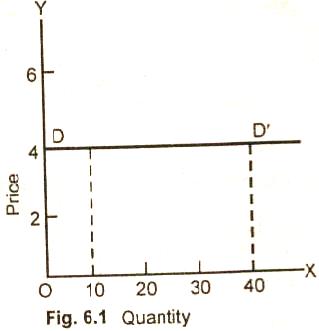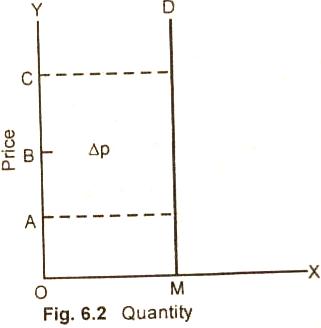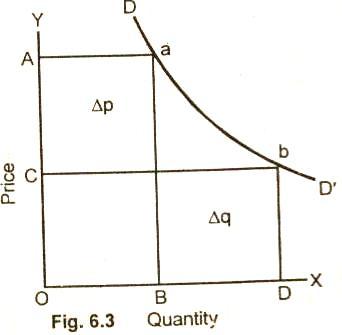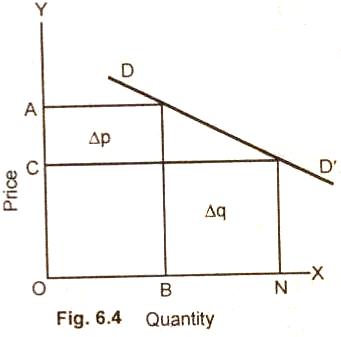Degrees of Elasticity of
Demand:
We have
stated demand for a product is sensitive or responsive to price change. The
variation in demand is, however, not uniform with a change in price. In case of
some products, a small change in price leads to a relatively larger change in
quantity demanded.
Elastic and Inelastic Demand:
For example,
a decline of 1% in price leads to 8% increase in the quantity demanded of a
commodity. In such a case, the demand is said to elastic. There
are other products where the quantity demanded is relatively unresponsive to
price changes. A decline of 8% in price, for example, gives rise to 1% increase
in quantity demanded. Demand here is said to be inelastic.
The terms
elastic and inelastic demand do not indicate the degree of responsiveness and
unresponsiveness of the quantity demanded to a change in price.
The
economists therefore, group various degrees of elasticity of demand into
five categories.
(1)
Perfectly Elastic Demand:
A demand is perfectly elastic when a small
increase in the price of a good its quantity to zero. Perfect elasticity implies
that individual producers can sell all they want at a ruling price but cannot
charge a higher price. If any producer tries to charge even one penny more, no
one would buy his product.
People would prefer to buy from another producer who
sells the good at the prevailing market price of $4 per unit. A perfect elastic
demand curve is illustrated in fig. 6.1.
Diagram:

It shows that the demand curve DD/
is a horizontal line which indicates that the quantity demanded is extremely
(infinitely) response to price. Even a slight rise in price (say $4.02), drops
the quantity demanded of a good to zero. The curve DD/ is infinitely
elastic. This elasticity of demand as such is equal to infinity.
(2)
Perfectly Inelastic Demand:
When the
quantity demanded of a good dose not change at all to whatever change in price,
the demand is said to be perfectly inelastic or the elasticity of demand is
zero.
For example,
a 30% rise or fall in price leads to no change in the quantity demanded of a
good.
Ed = 0
30%
Ed = 0

In figure 6.2
a rise in price from OA to OC or fall in price from OC to OA causes no change
(zero responsiveness) in the amount demanded.
Ed = 0
Δp
Ed = 0
(3)
Unitary Elasticity of Demand:
When the quantity demanded of a good changes
by exactly the same percentage as price, the demand is said to has a unitary
elasticity.
For example, a 30% change in price leads to 30% change quantity
demand = 30% / 30% = 1.
One or a one
percent change in price causes a response of exactly a one percent change in the
quantity demand.

In this figure (6.3) DD/ demand curve with unitary
elasticity shows that as the price falls from OA to OC, the quantity demanded
increases from OB to OD. On DD/ demand curve, the percentage change
in price brings about an exactly equal percentage in quantity at all points a,
b. The demand curve of elasticity is, therefore, a rectangular hyperbola.
Ed = %∆q
%∆p
Ed = 1
(4)
Elastic Demand:
If a one
percent change in price causes greater than a one percent change in quantity
demanded of a good, the demand is said to be elastic.
Alternatively, we can say that the elasticity of demand is greater than. For
example, if price of a good change by 10% and it brings a 20% change in demand,
the price elasticity is greater than one.
Ed = 20%
10%
Ed = 2

In figure
(6.4) DD/ curve is relatively elastic along its entire length. As the
price falls from OA to OC, the demand of the good extends from OB to ON i.e.,
the increase in quantity demanded is more than proportionate to the fall in
price.
Ed = %∆q
%∆p
Ed > 1
(5) Inelastic Demand:
When a change
in price causes a less than a proportionate change in quantity demand, demand is
said to be inelastic.
The
elasticity of a good is here less than I or less than unity. For example, a 30%
change in price leads to 10% change in quantity demanded of a good, then:
Ed = 10%
30%
Ed = 1
3
Ed < 1

In figure
(6.5) DD/ demand curve is relatively inelastic. As the price fall
from OA to OC, the quantity demanded of the good increases from OB to ON units.
The increase in the quantity demanded is here less than proportionate to the
fall in price.
Note:
It may here note that the slope of a demand curve is not a reliable indicator of
elasticity. A flat slope of a demand curve must not mean elastic demand.
Similarly, a steep slope on demand curve must not necessarily mean inelastic
demand.
The reason is
that the slope is expressed in terms of units of the problem. If we change the
units of problem, we can get a different slope of the demand curve. The
elasticity, on the other hand, is the percentage change in quantity demanded to
the corresponding percentage change in price.
Relevant Articles:
|